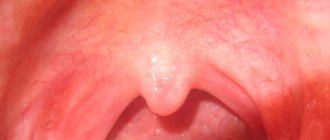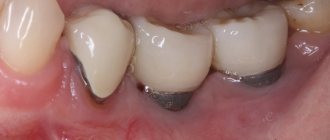Throat cancer: treatment
There are many treatment regimens for malignant throat tumors, which are selected on an individual basis. To select treatment tactics, the doctor assesses the stage of the disease and the physiological state of the patient.
Radiation therapy in the treatment of tumors of the throat and larynx
Radiation therapy involves exposing cancer cells to ionizing rays. Under the influence of radiation, processes in tumor tissues are disrupted, as a result it stops progressing and decreases in size.
Depending on the stage of cancer development, external or internal radiation therapy is used. External irradiation is carried out non-contactly - ionizing rays are directed at the tumor area, but healthy tissue is also affected, causing side effects.
Irradiation is carried out in short courses of 5-7 days with breaks. The entire course of treatment may take 1-2 months, depending on how the patient responds to therapy.
Internal radiation therapy - brachytherapy - is a modern method in which a capsule with a radioactive substance is injected into the tumor for a certain time. With brachytherapy, healthy tissue is practically not damaged.
When is chemotherapy used for throat cancer?
Chemotherapy for throat cancer involves taking antitumor drugs (cytostatics) that suppress the proliferation and kill cancer cells.
Chemotherapy is prescribed in several cases:
- to reduce tumor size before surgery or radiation;
- to prevent recurrence after cancer removal;
- as the primary treatment if surgery is not possible.
Chemotherapy drugs:
- 5-fluorouracil (500 mg/m2 3-5 days, interval 4 weeks).
- Docetaxel (75 mg/m2, every three weeks).
- Methotrexate (15-30 mg/day for five days with an interval of 1-4 weeks).
- Cisplatin (50-120 mg/m2 every 3-4 weeks).
- Vepesid (50–100 mg/m2 for five days, with a break of 4 weeks).
These chemotherapy regimens are approximate. The dosage of the drug and the frequency of administration are adjusted by the doctor on an individual basis.
Targeted therapy
Targeted therapy is a modern and highly effective treatment for throat cancer. It consists of taking drugs whose action is aimed at destroying only cancer cells. During treatment, biochemical processes in healthy tissues are not disrupted, so side effects are minimal.
Main drugs and doses:
- Herceptin - (single 4 mg/kg, then 2 mg/kg once a week).
- Avastin (5-10 mg/kg once every 2 weeks).
- Cetuximab (400 mg/kg once a week).
Targeted therapy is prescribed as the only treatment for throat cancer, or in combination with chemotherapy or ionizing radiation. Often prescribed to elderly patients whose health condition does not allow them to undergo surgery.
Surgical treatment of throat cancer
The main treatment for throat cancer is surgical removal of the tumor. To prevent cancer relapse, a course of cytostatics or radiation therapy is prescribed before or after the intervention.
At stage 1 of the disease, the tumor is removed or laser cauterization is performed. At stages 2-3 of cancer, removal of the tumor in the throat along with the affected tissues and lymph nodes is required.
After surgery for throat cancer, an endoprosthesis or plastic surgery is required to restore the structure of the throat and the ability to fully eat and speak. Plastic surgery is performed several months after tumor removal, when the patient’s body has fully recovered.
When are Gamma Knife and Cyber Knife systems used?
Gamma knife and cyber knife are modern methods of radiosurgery used to remove throat tumors. Both methods do not require incisions and involve exposing tumor tissue to radiation. As a result, cancer cells are destroyed, the tumor completely disappears or significantly decreases in size.
Both methods are highly accurate and have virtually no effect on healthy tissue. But there are slight differences - cyber knives have a higher radiation dose, but have small errors in the accuracy of the impact. In addition, the gamma knife is used primarily for brain tumors, and the cyber knife can be adapted to cancer of any location.
Throat cancer symptoms in the early stages
70% of all diagnosed cancers affect the larynx. Throat cancer is more common among the stronger sex, whose age is over 40 years.
A malignant tumor develops on the mucous membranes of the larynx and pharynx. In the absence of timely treatment, the pathological process spreads throughout the body.
Causes of the disease
Scientists have not identified reliable causes of the disease. It is believed that the impetus for the development of pathology can be given by bad habits - drinking alcohol and smoking, as well as genetic predisposition.
Throat cancer is less common in women than in men
Possible causes of the disease include:
- inhalation of toxic fumes while performing professional duties - dust from coal, fumes of heavy metals, etc.;
- excessive consumption of salty and spicy foods;
- chronic diseases of the pharynx.
Sometimes throat cancer occurs due to the transformation of papillomas on the throat mucosa into cancer cells.
Stages of cancer
According to the stage of its progression, the disease is usually classified into 5 categories:
- Stage 0. The boundaries of the tumor at this stage of development do not penetrate beyond the epithelium. With proper treatment, the pathology is treatable.
- Stage 1. Gradually, cancer cells leave the epithelium without damaging nearby organs. For stage 1 throat cancer, the prognosis is favorable with timely diagnosis of the disease and immediate treatment.
- Stage 2. Cancer cells from the larynx metastasize to neighboring tissues. The success of therapy depends on the size of the formation and its location.
- Stage 3. Characterized by the presence of cancer cells in the lymph nodes without the formation of distant metastases.
- Stage 4. Cancer cells spread to distant organs - the brain, bronchi, lungs and stomach. The fourth degree of pathology can be detected without professional diagnostic tests.
Note! Stage 4 throat cancer is an incurable disease. It is impossible to get rid of cancer cells even if the primary tumor is destroyed
Smoking is one of the main causes of throat cancer
The first symptoms of pathology
The first signs of throat cancer appear vaguely and are similar to the symptoms of colds - pharyngitis or tonsillitis. Many men do not consider these signs to be pathological at all, since they often notice a similar clinical picture when smoking.
Throat cancer in women in the early stages manifests itself:
- pain in the throat;
- decreased sense of taste;
- gradual change or loss of voice;
- deterioration of hearing;
- loss of appetite;
- sudden weight loss;
- swelling of the neck.
As the pathology develops, the signs of cancer of the throat and larynx become more intense. Typically, patients seek professional help at the moment when throat cancer has reached stage 2-3.
Symptoms of throat cancer in men may include the following signs: a persistent dry cough, blood in the sputum and nasal discharge.
One of the symptoms of throat cancer can be a bloody nose.
Symptoms in later stages
As the pathology progresses, ulcers and white plaque appear on the larynx. The photo shows what throat cancer looks like in its final stages.
Late stage throat cancer
The patient experiences severe discomfort when swallowing food and saliva. For this reason, he consumes food less and less and is gradually losing weight. A lingering dry cough is a concomitant symptom of the disease, is practically untreatable and prevents a person from eating and resting normally.
Symptoms of advanced throat and larynx cancer are as follows:
- lack of oxygen;
- food in throat;
- paroxysmal pain in the ears;
- rise in body temperature;
- hemoptysis;
- hoarseness of voice.
Types of throat cancer
Depending on the location of the tumor process, several types of the disease are distinguished:
- Epiglottis cancer. The main symptom of the disease is acute pain in the throat associated with irritation of nerve endings and their deformation. Patients cannot swallow food normally because the passage to the throat is blocked by the affected mucous membranes.
- Upper throat cancer. Symptoms of the pathology are deepening of the voice, sensation of a foreign object in the throat. Signs of the disease appear only in the last stages, which causes late consultation with a doctor.
Symptoms and signs of throat cancer by stage
Diagnosing the disease is difficult, and the question of how to determine throat cancer is therefore relevant. The first signs are confused with a cold. Then the symptoms become more obvious. What may be early signs of cancer:
- regular pain in the larynx;
- small tumors on the neck;
- difficulty swallowing;
- cough;
- mild pain in the ear.
Initial
The disease starts from the zero stage, the neoplasm of insignificant size does not extend beyond the mucous membrane of the larynx. There are no symptoms of cancer, and the disease is rarely detected. The next stage is the first. The tumor protrudes slightly beyond the mucous membrane of the larynx, but does not spread to other tissues. The voice begins to change, the chords vibrate.
2nd degree
The cancer begins to appear, the tumor takes over the entire department, goes to the neighboring one, the vocal folds may swell, their work is disrupted. The patient breathes with noise, the voice becomes hoarse, the lymph nodes are not yet affected. At this stage, the disease affects only the larynx, located in one of the parts:
- Epiglottis, upper. Several foci develop in it, and infection affects the surrounding tissues.
- The glottis, with the capture of the subpharyngeal part, leads to disruption of the movement of the vocal cords.
- Subpharyngeal region, the lowest part of the larynx.
Stage 3
The tumor grows to all laryngeal walls, and the mobility of the vocal cords is impaired. At this stage, there is no question of how to recognize cancer; it manifests itself definitely. The person speaks hoarsely, or may even lose his voice. Other signs of throat cancer in women and men at the third stage:
- tumor of the larynx, lymph nodes (they increase in diameter up to 3 cm);
- wet cough, bloody sputum;
- difficulty swallowing or inability to do so;
- smell of rot from the mouth.
Stage 4
The tumor has grown, metastases have spread to the lymph nodes and other organs. The fourth stage of throat cancer has three stages: A, B and C. The progression of the disease goes like this:
- IV A. The cartilage of the thyroid gland and the tissue surrounding the larynx are affected. The tumor penetrates the neck, trachea, esophagus, lymph nodes can be infected, they increase to 6 cm.
- IV B. The spinal canal is captured, the tumor surrounds the carotid artery, affects the tissues and organs in the chest cavity, the lymph nodes reach large sizes.
- IV C. Not only metastases, but also the tumor itself extends beyond the larynx.
Symptoms and manifestations of cancer at stages 3 and 4
Advanced throat cancer is accompanied by pronounced symptoms that bring painful sensations to the patient, which is associated with the extensive spread of the tumor and damage by abnormal cells not only to the mucous membrane, but also to the deep layers of the muscles of the laryngeal region, as well as their germination into nearby and distant internal organs. Throat cancer, which has reached the final stages of development, manifests itself in a large number of negative changes that are directly related to the extent of the spread of the oncological process and the presence of damage to internal organs.
All changes in the body that occur in the final stages of the disease accompany specific symptoms of throat cancer:
- severe pain in the laryngeal region;
- the appearance of an unpleasant, putrid odor from the mouth;
- constant shortness of breath not associated with physical activity;
- partial numbness and deformation of certain areas of the neck and face;
- a feeling of a foreign object in the throat that interferes with swallowing movements.
Pain in cancer that has reached the terminal stage of development can appear not only from the growth of the tumor structure and compression of the nerve roots. Quite often, pain occurs after courses of radiation therapy, causing burns of the skin and oral mucosa.
What causes angioedema of the larynx?
In most cases, this is the body’s response to allergens entering it. These allergens are purely individual. They may cause a negative reaction in one person and not at all in another. The difference in the perception of allergens depends on the characteristics and strength of the immune system.
But there is also non-allergic angioedema, which can develop in response to various physical factors (cold, overheating, strong solar radiation, vibration), severe stress (emotional stress or increased physical activity, prolonged lack of sleep), lack of vitamins and essential microelements. The disease is associated with a deficiency of a special enzyme, the C1 esterase inhibitor, which blocks the action of vasoactive peptides. In this case, an immunological reaction develops like an allergy in the absence of an allergen. Most often, non-allergic Quincke's edema is a genetic failure that prevents the production of the necessary enzyme by liver cells.
The most common factors that provoke angioedema:
- medicines;
- Food;
- household chemicals;
- flowering plants, pollen;
- mushrooms, fungal spores;
- dust;
- animal hair;
- alcohol;
- stinging insect bites;
- ultraviolet;
- hypothermia or overheating;
- stress;
- indigestion (undigested fragments of food proteins (peptides) can cause allergization of the body and provoke Quincke's edema);
- liver diseases.
Once in the body, allergens provoke the release of serotonin, histamine and other mediators of allergic reactions into the blood. These substances cause pathologically strong permeability of the vascular walls located in the subcutaneous fatty tissue and submucosal layer. As a result, blood begins to leak from the lumen of the vessels, which leads to the development of angioedema. However, this condition may not develop instantly. Having accumulated allergens in critical quantities, the body can react sharply after some time.
There is also an idiopathic form of the disease, the root cause of which cannot be determined.
Main symptoms of the disease
The development of distinct symptoms occurs in stages 2-3. The characteristic symptom complex consists of general and local manifestations.
Among the signs of the disease:
- Weakness, drowsiness.
- Lack of appetite. This symptom of throat cancer is caused by the disintegration of the tumor and the impact on special centers of the brain.
- Development of the anemic process. Due to constant bleeding and poisoning of the body with tumor decay products. Manifested by sideropenic and anemic syndromes (not always).
- The patient becomes strange, he develops perversion of taste and smell.
- Increase in body temperature for no apparent reason to subfebrile levels. The body perceives the tumor as a dangerous intruder. In addition, the brain is poisoned by toxins. Hence the low-grade fever.
- Manifestations of general intoxication of the body. This includes migraines, dizziness, and decreased performance.
These are just general manifestations. Local signs of throat cancer are much more noticeable:
- Pain in the throat. Localized at the level of the Adam's apple, slightly lower or higher. The nature of the pain is pressing, pulling, bursting. Other types of pain are also possible. It all depends on the type of process and the characteristics of the patient’s body.
- Catarrhal phenomena, including swelling.
- Changing the relief of the neck. Massive hemorrhages in the throat area are possible, which are manifested by changes in pigmentation at the local level. The dermis becomes red, capillaries and vascular networks are visible. More often, this symptom appears in the later stages of the disease.
- Sensation of a foreign object in the throat. Feels like a lump or bone stuck in the throat.
- Numbness of the face, paresthesia (feeling of goose bumps), violation of facial symmetry due to disruption of innervation at the local level.
- Periodically, the patient chokes on food, and swallowing function is suppressed (secondary dysphagia), which is manifested by the inability to eat normally. First, the consumption of solid and then liquid food is disrupted.
- Changing the timbre of the voice up to its complete loss. In this case, standard methods of conservative treatment do not help.
- Bitterness in the mouth, metallic taste. Such phenomena are caused by tumor disintegration or minimal hemorrhages. The condition cannot be corrected with medications. It is necessary to carry out differential diagnosis. There are other options besides cancer.
- Putrid odor from the mouth due to the disintegration of the tumor and its pyogenic transformation (the cells are dividing rapidly, but there is not enough nutrition for all of them, the neoplasm is disintegrating).
- Dry cough of a constant or periodic nature. The reflex is unproductive, haunts the patient and causes a significant decrease in quality of life.
- Change in body weight. As a rule, in the direction of decrease, since the body devotes all its strength to fighting the tumor.
- Exudation. Usually bloody, putrid in nature. The manifestation is especially strong in the morning.
- Breathing disorders. Like shortness of breath or suffocation.
- Enlarged cervical lymph nodes (secondary lymphadenitis). It manifests itself as lumps of characteristic localization and pain.
- Bleeding from the throat. In the later stages, it is quite capable of becoming lethal due to its massiveness.
These are symptoms of an oncological process at stages 2-3, i.e. its developed form.
Upon visual assessment, throat cancer looks like a small neoplasm, pale pink in color, with a loose, grayish structure on the cut (in the photo, the initial 1st stage).
It is impossible to differentiate tumors from each other on your own. Sometimes they are impossible to even notice.
There are other manifestations, it all depends on the location of the tumor.
If the indicated symptoms in the amount of one or two or more are noticed by the patient himself, he should urgently run to the doctor.
The structure of the throat and the location of the tumor in it
The throat consists of two sections - the pharynx and larynx. When people talk about throat cancer, they usually mean tumors of the larynx - this section is most susceptible to mechanical trauma and negative effects.
The larynx consists of three sections:
- Upper or vestibular - it is in this section that the formation of cancerous tumors most often begins. The development of cancer in the vestibule of the larynx causes symptoms similar to ARVI, which often delays the patient’s visit to a specialist. Due to the large number of blood and lymphatic ducts, the location of cancer in the upper pharynx is the most unfavorable.
- Average. Throat cancer, which forms in the middle part of the larynx, is localized in the anterior vocal folds, disrupting their movement. Therefore, the first manifestations are voice disturbances and hoarseness. There are a small number of lymphatic ducts in the middle section, so metastasis is unlikely.
- The lower one is the least affected. The peculiarity of tumors is that they almost do not rise above the mucous epithelium and often grow downward. In aggressive forms of cancer, it quickly metastasizes to the prevertebral and thoracic region.
Less common is pharyngeal cancer. Most tumors are localized in the palatine tonsils, less often on the back wall of the pharynx and soft palate. Asymptomatic in the early stages and proximity to the lymph nodes allows pharyngeal cancer to quickly spread to surrounding tissues and distant organs.
Diagnosis of pharyngeal cancer
In the early stages, pharyngeal cancer practically does not manifest itself and its detection usually occurs by chance during general examinations by an otolaryngologist or dentist, on x-rays or ultrasound photographs. Suspicion may be caused by the throat and oral cavity: a specific check is necessary for enlarged tonsils, increasing pain, dysfunction of the masticatory-speech apparatus.
Diagnosis takes place in several stages, which allows you to get a complete conclusion. Doctors carry out:
- • survey, instrumental and digital examination of the oral cavity, throat;
- • laboratory tests: oncology test, cytology of the material taken during a biopsy (pharyngoscopy or tonsillectomy is performed to collect the material, however, if the cancer is localized in the tonsils, the cytological picture may be unclear);
- • otoscopy, radiography, CT, MRI to detect cancer, determine its location, and check for metastases.
Types
This form of cancer of the throat and larynx can have several main varieties, which differ in manifestation and approaches to their treatment.
Let's take a closer look at the types of laryngeal cancer:
- Squamous cell non-keratinizing cancer of the larynx.
This type of laryngeal cancer develops from non-keratinizing cells of the laryngeal mucosa. Its course is characterized by rapidity, and actively growing metastases can penetrate deep into the adjacent tissues of neighboring organs. This type of throat and larynx cancer is the most common; Its peculiarity is its development in the upper half of the throat (epiglottis) or in the tissues of the ventricle of the larynx, and the appearance of a tumor in one part with its gradual growth into the second half of the larynx is observed. During the development of a tumor of this type, a noticeable decrease in the lumen of the larynx occurs, and shortness of breath and loss of voice gradually appear in the patient. - Squamous cell keratinizing.
This type of cancer occurs on cells that tend to die over a period of time. The peculiarity of its development is its slow course and almost always the absence of metastases. Oral cancer can be observed in the area of a person's vocal cords. And the most dangerous form of squamous cell carcinoma is considered to develop in the lower parts of the throat - its rapid spread and significant metastasis are observed. At the same time, its detection is difficult, which makes the start of treatment too late. - Highly differentiated squamous cell.
This type of cancer of the throat and larynx is characterized by the involvement of a significant amount of healthy tissue in its development and spread, so the treatment process for this form of the disease is the most complex and lengthy. The supraglottic region of the larynx is most often affected by cancer; it is here that the development of all types of cancer occurs as quickly as possible with the formation of a significant number of metastases.
What are the stages of development of this disease and what are their external manifestations?
Throat cancer: photo and description
Laryngeal cancer is a malignant formation that spreads to the following organs:
- mucous membrane of the throat;
- nasopharynx;
- larynx.
It is characterized by aggressive development , and the tumor can spread to other nearby organs.
Laryngeal cancer practically does not develop as an independent disease, so you need to pay attention to precursor diseases, for which you need to urgently consult a doctor and take your health as seriously as possible.
Most often, throat cancer develops as a consequence of the following ailments:
- long and untreated inflammatory processes in the larynx;
- fibroids and cysts of the throat;
- scars and tissues on the laryngeal tissues;
- pachyderma and papilloma.
Treatment of laryngeal cancer
Laryngeal cancer is treated by a specialist. In this case, as with other cancers, an integrated approach is used. The most effective way to eliminate a malignant tumor is a combination of X-ray irradiation of the tumor, chemotherapy and surgery. The possibility and sequence of using these methods is determined by a specialist individually, depending on the stage and spread of the disease.
Surgeries for laryngeal cancer
There are several types of operations for laryngeal cancer. Some of them allow you to save part of the organ and the ability to speak. Others aim to completely excise the larynx and some adjacent structures. The ability to speak in this case is completely lost. The choice of one or another technique depends on the extent of tumor spread. Preference is given to operations that preserve at least part of the organ and the ability to speak:
- partial removal of the vocal fold (chordectomy);
- partial excision of the cartilage of the larynx and vocal fold on the side of the tumor (frontal resection of the larynx);
- partial removal of the epiglottis cartilage (resection of the epiglottis).
If the disease has spread significantly, laryngectomy is used - complete excision of the organ. The operation can be supplemented by partial removal of the cervical lymph nodes - lymph node dissection. To allow free access of air into the lungs after laryngectomy, a hole is created on the anterior surface of the neck connecting the trachea with the external environment (tracheostomy).
After laryngectomy, you can speak with a voice prosthesis
X-ray exposure
Laryngeal cancer responds well to X-ray therapy. The main goal is to eliminate or reduce the tumor in size. The radiation dose is calculated individually. X-rays are directed with great precision to the area of the tumor. A special mask is used to protect the skin of the face and neck organs.
Laryngeal cancer is sensitive to radiation
Of course, this type of tumor treatment is associated with side effects - loss of taste, weakness, sore throat, loss of appetite. However, upon completion of treatment, these negative phenomena disappear on their own.
Chemotherapy
Chemotherapy is one of the components of treatment for laryngeal cancer. For this purpose, antitumor drugs are prescribed:
- Methotrexate;
- Azathioprine;
- Cisplatin;
- Cyclophosphamide.
To combat the tumor, it is currently proposed to use drugs that block the growth of new vessels in the tumor mass (for example, Bevacizumab).
Avastin contains bevacizumab
Laryngeal cancer, what is it?
Throat cancer is a malignant tumor that can affect different parts of the laryngopharynx. It is capable of exophytic (outward) and infiltrative (inward) growth, and in the process of its development gives distant and regional metastases. Laryngeal cancer is a tumor affecting one of the parts of the throat - the larynx.
photo
Usually this formation is detected in elderly and senile patients, but it can also appear in a child. Throat cancer occurs several times more often in males than in females.
Among the factors that contribute to the development of this pathology, tobacco smoking comes first. Some importance is attached to occupational hazards (dust, inhalation of gases, etc.), alcohol, increased stress on the voice (singers, teachers, etc.).
Often a cancerous tumor develops against the background of existing pathological conditions of the hypopharynx. Thus, in approximately half of the patients, throat cancer developed against the background of chronic laryngitis (hyperplastic form).
A throat tumor can form as a mature (keratinizing, differentiated) or immature (more malignant, poorly differentiated) form.
A mature tumor develops more slowly, it metastasizes less often and at a later stage. Immature, poorly differentiated cancer grows much faster and metastasizes to other organs and tissues early.
Depending on which area the tumor affects, there are:
1. Pharynx cancer. It is rare and occurs mainly in males. Carcinomas and sarcomas usually develop in this area. Early symptoms are very sparse, but this section is easier to examine, so there is a good chance of detecting a tumor in the early stages.
2. Cancer of the upper larynx. One of the most unfavorable tumor locations in terms of patient survival. Occurs in 15-20% of cases. This area is well supplied with blood, therefore, with the development of the tumor process, extensive and early metastasis occurs.
The first signs of laryngeal cancer are very mild and patients often confuse them with inflammation and infection. This leads to the pathology being diagnosed at a later stage.
3. Tumor of the middle part of the larynx. Occurs in more than half of patients; this is a prognostically “favorable” form of cancer.
The tumor usually appears on the vocal folds - this area has few lymph nodes, so metastases are either not observed at all or develop at a very late stage. Clinically, patients notice it much earlier due to the onset of voice problems.
4. Cancer of the lower larynx. Rarely seen. This section is rich in lymphatic vessels and is well supplied with blood, so the tumor metastasizes early.
Features of the development of metastases, depending on the location of the oncology
Supraglottic section
There is a well-developed lymphatic network here, which helps the tumor quickly spread throughout the local and regional localization. Metastases mainly affect the upper and middle group of lymph nodes located in the deep jugular chain - 50-60% of cases. Metastases are localized:
- in 57% of cases on the side of the tumor;
- in 9% - on both sides of the larynx;
- in 6.3% - contralaterally, that is, on the side opposite to the tumor.
Vocal folds
Due to the low lymph circulation, metastases are rarely observed here. In 5-12% of cases they are found in the middle deep jugular lymph nodes.
Subglottic department
Regional metastases occur in 5-12% of cases. Moreover, in 20% of cases they develop in the pretracheal and prelaryngeal lymph nodes. Lymph moves towards the lower deep jugular lymph nodes, where metastasis is also diagnosed.
Distant metastases are most often diagnosed in the ribs, lungs, and mediastinum.
Diagnosis, stages of the disease
If you are concerned about symptoms characteristic of a cancerous tumor, you should consult a doctor.
First you need to visit an otolaryngologist, who will ask about your problems and conduct an examination of the oral cavity and pharynx.
To assess the condition of the larynx, he can use a special endoscopic instrument - a laryngoscope.
Such an examination will be more informative than a simple examination of the oral and nasal cavities.
Most likely, instead of cancer, the specialist will discover another, less serious disease that gives such symptoms, and will prescribe treatment.
If the otolaryngologist suspects the presence of a tumor, he will prescribe additional examinations and refer the patient for a consultation with an oncologist.
To clarify the diagnosis, a blood test for tumor markers may be prescribed. However, the most accurate diagnostic method is a biopsy.
A specialist uses a special needle to take tissue samples to study. After such a test, a diagnosis can be made with one hundred percent probability.
Ultrasound of the neck and lymph nodes, computed tomography and magnetic resonance imaging, chest X-ray, and bronchoscopy help to clarify the stage of development of the disease.
Computed tomography allows you to obtain three-dimensional images of a malignant tumor, determine its exact size and location.
Stages of development:
- The first stage - the tumor spreads to only one part of the larynx, it is limited to an area of the mucous membrane or submucosal layer, the organ retains full mobility, there are no metastases.
Stage two - cancer has spread to one part of the larynx, there are no metastases.
Stage three - the tumor affects more than one part of the larynx, has one regional metastasis, and movement of the vocal cords is difficult.
Stage four - the tumor grows into tissues located adjacent to the larynx, it has distant metastases or metastases in the lymph nodes.
Classification, types of laryngeal tumors
Almost all malignant tumors of the larynx are squamous cell carcinoma, which develops from cells of the mucous membrane. This is often preceded by precancerous changes. Often, dysplasia does not transform into cancer and disappears on its own, especially if the damaging factors are eliminated - for example, a person quits smoking.
In some cases, precancerous changes transform into “cancer in situ.” It does not grow beyond the mucous membrane and can be successfully treated if detected early. Cancer in situ is a stage zero tumor. If left untreated, it will progress further. The stage gradation varies depending on which part of the organ the malignant tumor is located in. The table summarizes the classification by stages:
Stage I
Above the vocal cords: the tumor is located within the upper part of the larynx, does not spread to other parts and does not interfere with the functioning of the vocal cords. Regional lymph nodes are not affected, there are no distant metastases.
In the area of the vocal cords: the tumor has grown deeper than in situ cancer, but does not impair the mobility of the vocal cords. There are no metastases, no lymph nodes are affected.
Under the vocal cords: the tumor is located within the lower level of the larynx, does not spread to the lymph nodes and does not give distant metastases.
Stage II
Above the vocal cords: The tumor has spread to more than one part of the larynx but is still not affecting the movement of the vocal cords.
In the area of the vocal cords: the tumor has spread to more than one part of the larynx and/or the mobility of the vocal cords is impaired.
Under the vocal cords: The tumor spreads to more than one part of the larynx and may impair the mobility of the vocal cords.
Stage III
Above the vocal cords: the tumor impairs the mobility of the vocal cords and/or grows into the surrounding tissue.
In the area of the vocal cords, under the vocal cords: the tumor impairs the mobility of the vocal cords, or spreads into the surrounding tissues, or there is one lesion measuring less than 3 cm in the regional lymph nodes.
Stage IV
Above, below and in the area of the vocal cords : the tumor spreads more strongly to the surrounding tissues, regional lymph nodes, and there are distant metastases.
adenocarcinomas occur in the larynx . They are found very rarely, but over the last 20 years, according to UK statistics, their prevalence has been increasing.
Diagnosis of the disease
Like any malignant tumor, throat cancer must be detected as early as possible, because only in this case is it possible to achieve positive results from treatment.
If symptoms of throat cancer appear in the early stages, you should visit an ENT specialist who will prescribe all the necessary examinations. Examination of the pharynx allows you to establish the occurrence of any neoplasm
The doctor pays special attention to the condition of the cervical lymph nodes, the enlargement of which is the first sign of cancer. Using palpation, their consistency, size and mobility are determined.
As the tumor develops, the lymph nodes become denser, enlarge, and their poor displacement is observed until they are completely fixed in the tissues.
The main method for diagnosing the symptoms and first signs of throat cancer at an early stage is laryngoscopy, which allows you to see the tumor in the vestibular region, as well as on the vocal folds. For a more detailed diagnosis, laryngoscopy is complemented by the use of microscopes (microlaryngoscopy).
Very often, for diagnostic purposes of symptoms of throat cancer in the early stages, X-ray studies, CT and MRI are used, which makes it possible to assess the condition of the throat in various projections.
A mandatory component of diagnostic measures is histology. When laryngoscopy determines the presence of a malignant neoplasm, but histological examination does not confirm it, a repeat biopsy may be performed. Such cases may be associated with superficial collection of biological material, as well as the presence of inflammation in the tumor and its combination with a concomitant disease, for example, tuberculosis.
The first symptoms of throat cancer in the photo presented in the article reflect the area where the disease is localized.
If, after a three-fold biopsy, it is not possible to establish a diagnosis, the patient undergoes removal of the tumor (partially or completely) and sends it for urgent histological examination. If the diagnosis is determined, surgical measures continue with the removal of the larynx according to the technology adopted for the treatment of such diseases.
Despite the relatively small range of diagnostic techniques for determining laryngeal cancer, its early detection is quite possible.
What to do if you notice symptoms of throat cancer in the early and late stages?
Diagnostic methods
First, let's present the differential diagnosis table
| Form of the disease | Clinical picture |
| Papilloma in the larynx | Usually occurs on the vocal cords, less commonly affects the epiglottis, finely lumpy, pale gray, the patient experiences hoarseness |
| Leukoplakia | A white spot with an uneven surface is found on the vocal cords; most often it is located behind the arytenoid cartilaginous structures, characterized by impaired phonation and coughing. |
| Contact form vocal process fibroids | Located in the back parts of the vocal folds, on one of them it resembles a hammer, on the other - an anvil, the patient’s voice changes |
| Laryngeal fibroids | Located in the anterior third of the vocal cords, sometimes have a wide base and arise from the laryngeal ventricle or vestibular ligament |
Diagnosis of this disease includes physical and instrumental examination methods.
Physical:
- collection of anamnesis of life and illness;
- examination and palpation (palpation) of the lymph nodes and larynx.
Instrumental:
- laryngoscopy (indirect);
- fibrolaryngoscopy, during which a targeted biopsy is performed;
- Ultrasound (performing puncture of lymph nodes under ultrasound control);
- Trepan biopsy of lymph nodes followed by histological examination of the biomaterial, which is crucial for making a diagnosis in oncology.
Let us consider diagnostic methods in detail and describe their features.
Laryngoscopy
- Indirect. It is used to determine the location and boundaries of the neoplasm, its growth patterns, the color of the mucosa, its integrity, the size of the lumen of the glottis, the level of mobility of the vocal folds, as well as the presence of inflammation of the cartilage and perichondrium of the larynx (chondroperichondritis).
- Fibrolaryngoscopy. Allows you to examine parts of the larynx that are not visible during direct laryngoscopy (epiglottis, laryngeal ventricles, anterior commissure, lining). During this procedure, a targeted biopsy is performed.
Laryngoscopy
X-ray techniques
The patient undergoes the following examinations:
- MRI/CT of the soft tissues of the neck using intravenous contrast - provides data on the spread of the pathological process throughout the parts of the larynx, and also provides information on the regional lymphatic collector;
- X-ray of the chest organs or CT scan of the chest and abdominal cavities using contrast.
X-ray research methods
X-ray research methods
Histological examination
In accordance with the histological structure, in 98% of cases, laryngeal cancer is represented by non-keratinizing or keratinizing squamous cell epithelium. Adenocarcinoma is less commonly diagnosed. In extremely rare cases (0.4%) – sarcoma.
Squamous cell well-differentiated cancer
General symptoms of the disease
In the early stages of the disease, general disorders appear. From the second stage, systemic changes begin.
Throat cancer - common symptoms:
- persistent dry cough;
- unpleasant smell of rot from the mouth;
- frequent sore throat;
- discharge of mucus from the nasopharynx mixed with pus or blood;
- difficulty, pain when swallowing;
- slight swelling in the neck area;
- paroxysmal pain in the ears;
- white spots, ulcers, plaque on the mucous membrane of the larynx.
Often the first signs of throat cancer in women are confused with manifestations of an allergy or viral infection. Usually, people with such pathologies do not go to doctors, preferring to treat themselves.
Women at risk should pay attention to such dangerous manifestations. These are lovers of cigarettes and alcoholic beverages, ladies over 60 years old, and also those with a genetic predisposition
These are lovers of cigarettes and alcoholic beverages, ladies over 60 years old, and also those with a genetic predisposition.
If you have general signs of pharyngeal cancer and risk factors, you should consult a doctor. At the initial stage, the disease is detected and treated successfully.
Symptoms of pharyngeal cancer at stages 2-3
The development of pathology leads to changes in the functioning of the vocal apparatus, which affects the timbre of the voice. Characteristic symptoms of throat and larynx cancer are a hoarse voice and a frequent dry cough.
The main symptoms of throat cancer in women:
- hoarseness, sometimes loss of voice;
- dry cough for no reason that cannot be treated;
- sore throat;
- feeling of a foreign object, “lump” in the throat;
- difficulty breathing;
- blood in sputum when coughing;
- enlarged cervical lymph nodes;
- unpleasant putrid odor from the mouth;
- the appearance of shortness of breath even in a calm state;
- toothache, tooth loss;
- weight loss for no apparent reason;
- low ability to work;
- increased fatigue;
- temperature increase to +38 °C.
These signs are characteristic of the second stage of development of malignant tumors.
Signs of throat cancer in advanced stages
Advanced laryngeal cancer in the process of spreading involves the deep layers of muscles and mucous membrane. This process is accompanied by suppression of the respiratory process.
The tumor can affect lymphatic and blood vessels. Metastases can spread to internal organs that are in close proximity, such as the lungs.
These changes in the body in the later stages of oncology give the corresponding signs:
- bad breath;
- taste disturbance (constant bitter taste);
- rapid weight loss;
- inability to open or close your mouth;
- increasing pain in the affected area;
- difficulty swallowing solid foods;
- hemoptysis;
- swelling of the cervical lymph nodes;
- feeling of a constant “lump” or foreign object in the throat;
- pain in the ears (possibly decreased hearing or complete loss);
- difficulty breathing (it becomes shallow, intermittent);
- disorders of the digestive system in the form of diarrhea or constipation.
With paralysis, the sick woman will have no facial expressions. Such symptoms are typical for stage 4 laryngeal cancer, which is often fatal.
Symptoms depending on the location of the cancer focus
Conventionally, there are 3 anatomical sections (from top to bottom) - nasopharynx, oropharynx, pharynx.
The most unfavorable prognosis for the formation of malignant neoplasms is found in the area of the nasopharynx - the upper part of the throat with the vault and lateral surfaces.
If the tumor is located in this area above the ligaments, the following symptoms will be present:
- hoarseness of voice;
- different tone of voice;
- pain when swallowing, radiating to the ears;
- feeling of a foreign object in the throat.
If the vocal cords are damaged, hoarseness will occur when speaking, especially with prolonged speech load.
The voice is often lost, leaving the ability to speak in a whisper. Aphonia develops, that is, the sound of the voice is lost, as the vocal cords vibrate and close poorly.
Signs of a tumor under the ligamentous apparatus:
- significant changes in voice;
- sore throat almost never stops;
- discomfort when speaking and swallowing;
- constant shortness of breath.
Oncology at this stage can be confused with manifestations of purulent tonsillitis. The throat turns red, the tonsils become coated.
When a sick woman sneezes, her ears and nose may become blocked, and she may experience frequent bleeding from both nostrils.
Precancerous diseases
Let's consider the pathologies that precede laryngeal cancer:
- laryngitis, which a person suffers from in a chronic form for many years;
- A special role in the emergence of this pathology is played by:
- most often - papilloma, which has existed for a long time, and leukoplakia of the mucous membrane lining the larynx;
- pachydermia;
- dyskeratoses;
- cystic formations on the laryngeal ventricles;
- broad-based fibroma;
- chronic inflammation that cannot be treated and is caused by smoking, alcoholism, and syphilis.
Laryngitis
Laryngitis
Papilloma
Papilloma
Leukoplakia
Leukoplakia
Second and third types
In the second case, the process of formation of a cancerous tumor involves cells of the mucous membrane that are not keratinized. First manifestations: high rate of development with an ever-increasing number of metastases, which are able to penetrate deeply into neighboring tissues. Location: upper parts of the throat or ventricle of the larynx.
Usually, with this type of disease, the tumor first bothers a person in one part of the throat, but over time it progresses and grows to the second half of the throat. Symptoms: hoarseness, shortness of breath, difficulty breathing due to narrowing of the lumen.
The third type is characterized by the spread of cancer over a large part of healthy tissue. The disease develops quickly, forming a large number of metastases.
Causes of pharyngeal cancer
The relevance of the problem of oncology forces medicine to carefully study the etiology of pharyngeal cancer. Conventionally, it is divided into autonomous and hormone-dependent; the role of psychosomatics cannot be completely excluded, although it has not been fully proven.
It is difficult to name clear reasons for the oncological process, but the main ones can be identified: smoking and drinking alcohol. Other factors that cause pharyngeal cancer include prolonged chemical, thermal or mechanical irritation. The pathogen that triggers malignancy at the genetic level is the human papillomavirus. Dependence on other ailments has also been discovered. It often forms in people with chronic diseases - leukoplakia and erythroplakia, pachyderma, dyskeratoses, benign fibromas, cysts, inflammations.
If we talk about heredity, then pharyngeal cancer is rarely inherited. However, children whose relatives had cancer on the female or male side are at risk because they are carriers of a gene that creates a predisposition. The incidence is also high in environmentally unfavorable areas.










